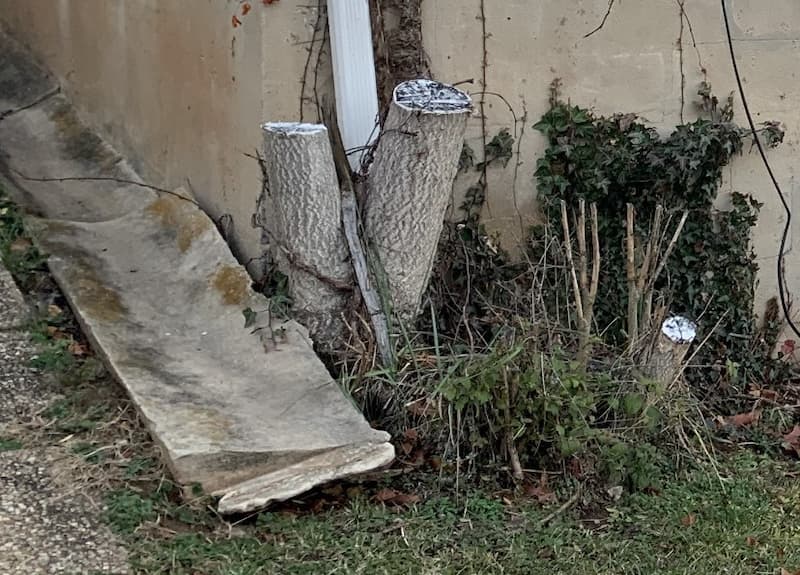I love planting trees and shrubs in my yard. I especially love foundation plantings – they help soften hard lines between a home and the surrounding landscape and give any house an inviting look.
Homes without foundation plantings or at least one anchor tree in the yard just look incomplete to me. But you can’t just stick any plants near your home.
This is easier said than done, especially when buying young plants at the garden center or nursery. They’re usually compact and look good just about anywhere in the yard at that stage, all cute and tidy in their pots. But wait until sun, water, and time take a hold. Those little plants grow, and grow, and grow some more. Some become giants, others don’t quite become as big as we hope.
And this is why it pays to know your stuff about the plants you want to grow in your yard. This is especially so for plants near your foundation, along driveways and sidewalks, or those situated near pools, sheds, or other fixed elements in your yard.
Think about it for a moment… You don’t want a massive oak growing three feet from your foundation. You’ll eventually curse a beautiful, tall shade tree dropping leaves and seed pods in your pool. And you’ll probably throw in the towel on landscaping if you planted bamboo anywhere near the windows around your home. But it doesn’t have to be this way!
There’s a saying in the hobby of coin collecting I’m going to throw in here… It goes “buy the book before the coin.” It means you should take the time to educate yourself on what you’re buying before you buy it. Doesn’t this make sense when it comes to buying plants, too?
#1 – Know Mature Plant Sizes Before You Buy – Especially When Planting Trees & Big Shrubs!
Before I buy any plant at the nursery, I try to imagine how big it’s going to be in five, 10, or 20 years. There’s a really easy way to get a ballpark idea on what that plant will look like down the pike. Many plants, especially those sold at big-box stores, come with tags that identify the plant and give you a quick rundown on average mature size, spacing suggestions, sun/shade requirements, and other vital stats. This is crucial information if you’re planting trees or shrubs near your home or other structures in your yard.

You could save yourself a world of future headaches and heartaches if you spend just a minute or two reading these tags before you buy your plants. You’d have no idea how many plants I shied away from after reading their tags and learning, on the spot – right there at the store – that they wouldn’t be a good fit for my yard. If you’re shopping at a nursery that doesn’t sell plants with these informational tags, take a moment to look up these plants’ mature sizes, sun/shade requirements, and other useful information on the spot using your smartphone.
#2 – Think About Plant Placement & Spacing
It’s not just about how tall a plant gets – it’s also about how wide. And whether you’re planting a single ornamental in a spot of the yard all by itself or arranging a neat row of hedges in front of your living room windows, you’ll need to think about how close is too close when it comes to plant spacing. Plants spaced too close to one another may eventually crowd each other out.
Always leave enough room between a plant and nearby walls or foundations to allow for painting or other maintenance. Don’t plant anything too close to HVAC system components, right in front of electric or water meters, or equipment like pool pumps. And think about potential issues you might eventually face with planting trees or shrubs too close to sidewalks or walkways. Will they eventually encroach on the path?
#3 – Consider the Roots When Planting Trees
One reason tree companies stay in business? Because so many people are planting trees that are just too big for their location. I wrote about this as it regards the ever-popular Norfolk Island pines, and I could list a bunch of other beautiful trees that don’t necessarily belong in small yards. But it’s not just about the girth of a tree trunk or size of a canopy that should concern you. You also need to think about the roots below ground – and it’s the roots that are sometimes a bigger problem than the rest of the tree.
Think of all the sidewalks, driveways, foundations, and even pools that have been cracked by invasive tree roots. Maybe you’ve dealt with this problem yourself, or perhaps you know of a friend or family member who has had to pay thousands of dollars to remove an offending tree and the damage it left thanks to invasive roots.

The bottom line here? Be careful about what you plant and where you plant it. Making wise decisions when buying and planting shrubs and trees now could make a huge difference down the line, and maybe even save you a ton of money.

2 responses to “Planting Trees & Shrubs? Here Are 3 Things You MUST Do First”
Good to know! That happened to C. Blythe Andrews Library. It had to be rebuilt because of invasive tree roots.
That’s a stunning example of why you should always be careful how close to buildings you plant trees!